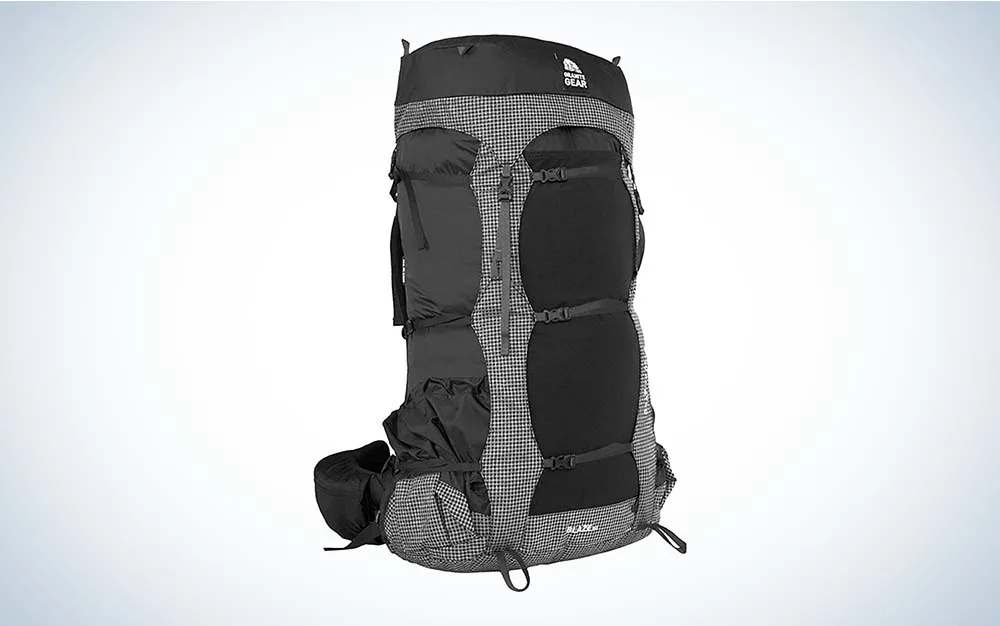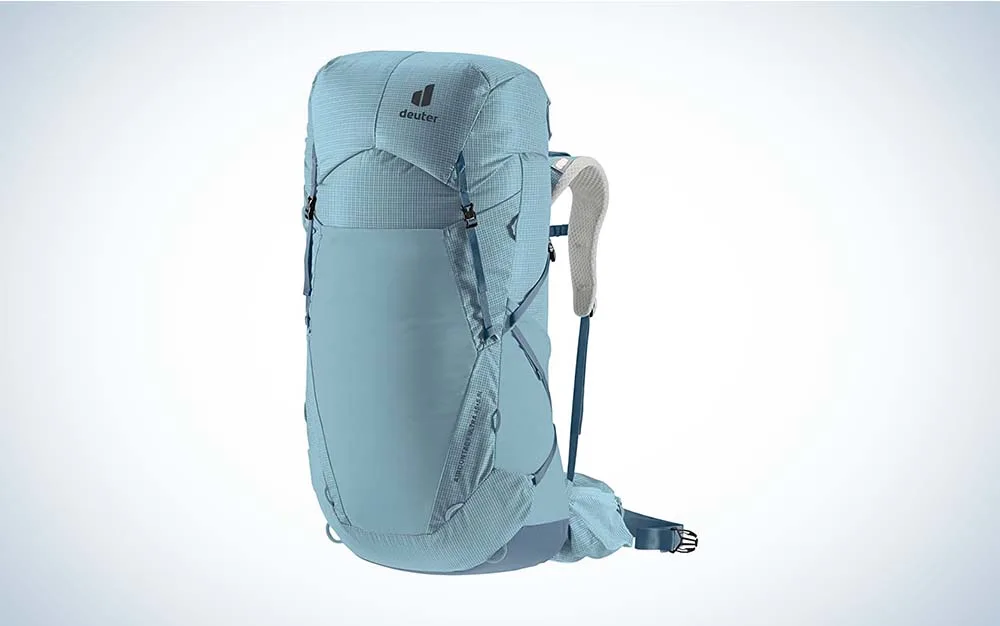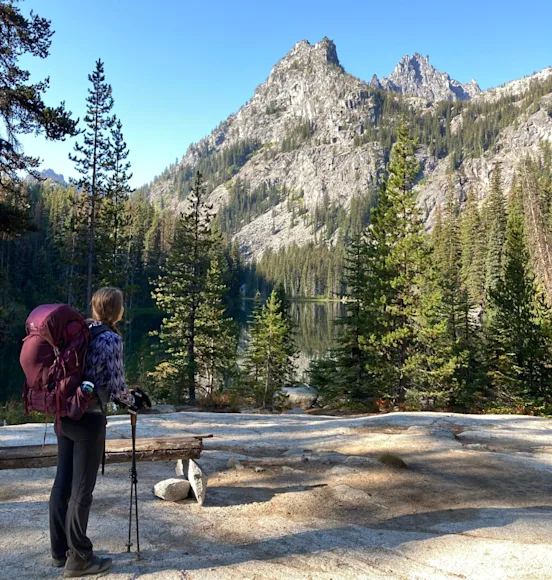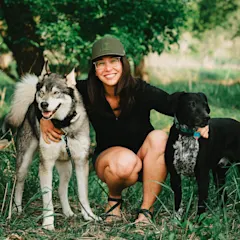_We may earn revenue from the products available on this page and participate in affiliate programs. Learn more ›
_
Best Overall

Osprey Aether / Ariel
LEARN MORE
Summary
Both the men’s and women’s backpack designs offer a high level of comfort even while carrying heavy loads.
Pros
Durable construction
Highly adjustable
Osprey Lifetime Warranty
Comfortable even when fully loaded
Cons
Water bottle is hard to access when the pack is on
Heavy
Best for Petite Women

Gregory Deva
LEARN MORE
Summary
It can be hard to find a backpack that fits petite bodies, but the Gregory Deva pack seems to have done the trick without compromising performance or comfort.
Pros
Innovative design
Easy access water bottle holder
Custom-fit rain cover included
Hydration pouch doubles as a daypack
Cons
May not suit all body types
Best Budget

Kelty Coyote
LEARN MORE
Summary
The Kelty Coyote offers a durable and functional backpacking option at an affordable price.
Pros
Large side pockets
Handles heavy loads
Available in three sizes and women’s fit (65L, 85L, 105L)
Affordable price
Excellent adjustability
Cons
Side pockets make it hard to access water bottles
Could use better ventilation
Kelty has a limited warranty
The best backpacking backpacks need to fit your recreation pursuits. While the trip distance, climate, group size, and your physical fitness level all influence which backpack best suits you, comfort is arguably the most important factor. After all, an ill-fitting backpack can become very uncomfortable very fast once it is loaded with gear. For example, although I am a woman, many women’s backpacks are uncomfortable for me because I have broad shoulders and a long torso. These little things make a big difference when you’re hiking for days on end.
Lightweight, comfortable, and ergonomic, all of the backpacks we feature on our list are internal frame backpacks
as external frames are much less common in modern backpack designs. To help you find the best backpacking backpack for your next trek, we also included a buying guide after our 2023 recommendations.
**Best Overall: Osprey Aether 65
**
**Best Lightweight: Granite Gear Blaze 60
**
**Best for Weekenders: Deuter Aircontact Ultra
**
**Best for Petite Women: Gregory Deva 60
**
**Best Budget: Kelty Coyote 65
**
How We Picked the Best Backpacking Backpacks
Choosing the best backpacking backpacks requires firsthand experience with products, backend research, verified customer testimonials, and conversations with brands. The first step in the process is to identify the best backpack brands and then narrow down potential options from each of them. During this process, we have specific categories in mind to help us guide our choices and to identify which backpacks might fit those categories best.
When selecting the best backpacking backpacks, we also considered the following:
Durability: What is the projected lifespan of the product? Is the pack made from durable materials? Is the product well made (i.e., how sturdy is the stitching)? Is there a repair policy or warranty?
Comfort: Is the backpack comfortable to wear for long periods, even when loaded? How does the pack distribute weight? Is the backpack adjustable? What type of suspension, ventilation, and padding does the backpack feature?
Features: How is the backpack organized regarding pockets, buckles, and straps? Are there any noteworthy features that enhance the backpacking experience? Do the backpack features fit my specific trekking needs?
Sustainability: How transparent is the company about its product messaging and manufacturing processes? How often do I plan to use the pack? What does a full life cycle assessment look like, and s a sustainability report available?
All products featured in this gear roundup are subject to change, and product descriptions may be updated as further gear testing occurs or new products enter the market. Updates specifically regarding durability are likely, so check back for changes or new recommendations.
The Best Backpacking Backpacks: Reviews & Recommendations
Best Overall: Osprey Aether 65
Best Overall

Specs (Aether 65 S/M)
Materials: Bluesign-approved 420HD nylon packcloth, PFC-free DWR
Capacity: 65L
Weight: 4.9 lbs
Pros
Durable construction
Highly adjustable
Osprey Lifetime Warranty
Comfortable even when fully loaded
Cons
Water bottle is hard to access when the pack is on
Heavy
Osprey is, across the board, one of the top picks for backpack brands because of its stellar lifetime warranty and repairs
for the duration of owning the pack. Even if you buy a secondhand backpack, it is easy to repair. While the men’s and women’s packs are made from highly durable nylon materials, things can still rip or break. So, get the most out of the backpack by ensuring you have the option to get it repaired when needed.
When looking at these Osprey packs specifically, the high level of adjustability makes them suitable for various hikers. While it is heavier than several other backpack’s on our list, the features, durability, and comfort countered the weight. The injection-molded AirScape™ back panel and custom fit options provide excellent weight distribution even when carrying a heavy load. Mesh-covered foam across the back panel ensures that while you’re hiking, there is enough ventilation between you and the pack to allow airflow. The attached hip belt has the same foam to provide more comfort for the wearer since most of the pack weight sits on your hips. While I like the attached hip belt and hip pockets, you may notice more pack movement stemming from the hip area when carrying a heavy load.
Most backpacking backpacks utilize a top-loading system. These packs offer that traditional backpack feel but provide easier access to items with multiple entry points to the main compartment. You can load from the top with the drawstring opening, especially when initially packing gear. Then, the front panel unzips and opens to the main compartment, making accessing items throughout your pack more convenient, either while unpacking or during breaks along the trail.
Best Lightweight: Granite Gear Blaze 60
Best Lightweight

Specs
Materials: 100D Robic High-tenacity nylon with Barrier DWR
Capacity: 60L
Weight: 3 lbs
Pros
Lightweight yet durable materials
Excellent weight distribution
Ideal organization
Minimal load shifting
Reinforced high-wear areas for added durability
Cons
Buckles are small and can be hard to use at times
Strap and hip padding absorb a lot of sweat when hiking in warm areas
The Granite Gear Blaze 60 is available in designs tailored to both men and women. While the features are primarily the same for both models, the women’s version has a fit better targeted to female anatomy within the back panel, hip belt, and shoulder straps. Granite Gear’s new Air Current frame is highly adjustable and comes in short, regular, and long torso lengths. Each sizing option has four shoulder strap attachment points, providing adjustability for a close-to-perfect fit. The hip belt features roomy pockets large enough to fit most cell phones and headlamps or a few snacks you like to keep accessible while hiking. The hip belt also offers excellent adjustability, fitting waist sizes from 26-42 inches.
In terms of lightweight backpacks, this one offers one of the best weight distributions and levels of comfort, even when carrying heavy loads. Its organization is typical of a standard backpacking backpack
, but all the pockets are well-intentioned and allow for ideal hiking access. Much like our top pick, this backpack has a top load for the main compartment and front zip access. The side water bottle holders are larger than those on other backpacks I’ve seen and they’re constructed so that they can fit up to two water bottles (sized from average smart water bottles). The combination of the mesh pouch on the front and the compression straps on the front of the pack give hikers a way to shed or add layers with ease or attach other gear, like sleeping pads, to the bag’s exterior.
The only notable thing that could be a con to some users is the small size of the buckles. If you wear gloves or have large hands, you may find them clumsy to open or snap shut.
Best for Weekenders: Deuter Aircontact Ultra
Best for Weekenders

Specs
Materials: 175D Polyamide Ripstop Ultra HD, PFAS Free
Capacity: 45 + 5L
Weight: 2.6 lbs
Pros
Lifetime Warranty
Highly customizable
Bluesign certified materials
Exterior attachments for additional gear
The Sternum belt is removable
Cons
Less back panel padding than other options
Designed to be a lightweight trekking backpack, the Deuter Aircontact Ultra provides a low-weight profile without compromising organization or comfort. Some hikers may be skeptical because the back panel doesn’t have as much padding as other backpacking packs on the market, but the way the pack is designed to distribute weight, it still provides the level of comfort needed for long hiking trips. I found the lumbar distribution design to work well to ensure that weight is distributed appropriately to provide a comfortable fit. With a smaller capacity ranging from 45-50L, it’s an ideal size for weekend trips or summer treks. To compensate for its interior size, there are compression straps and exterior pockets to attach gear to the outside of the backpack that doesn’t fit inside.
The lid or brain of the bag is removable, which is a nice feature for some circumstances, but I’ve never found myself needing to utilize that option. As a woman with broad shoulders, I was concerned that the straps would cut in when the pack was loaded. When fitted correctly, the pack distributes most of the weight to the hip and lumbar quite well, and even with a fully loaded pack, the shoulder straps are comfortable while hiking. I enjoyed the versatility of the exterior gear straps to secure items to the side or the front of the pack, and even though there is less padding on the back panel, it can be advantageous when hiking in hot weather.

Testing the Deuter Aircontact Ultra in the Cascade Mountains outside of Wenatchee, WA. – Meg Carney
Best for Petite Women: Gregory Deva 60
Best for Petite Women

Specs (Small)
Materials: 210D Honeycomb Cryptorip HD / 210D High Tenacity Nylon
Capacity: 60L
Weight: 4.6 lbs
Pros
Innovative design
Easy access water bottle holder
Custom-fit rain cover included
Hydration pouch doubles as a daypack
Cons
May not suit all body types
I considered labeling this hiking backpack
the best for women, but I found it best suited for petite women. Other backpacks like the Osprey Ariel or the Osprey Aura are also great options for women if this backpack doesn’t fit your specific needs or body type. I’ve heard from many female hikers that finding the right backpack as a petite woman takes a lot of trial and error, so it made sense to include this category among our picks to provide our best suggestion. The Gregory Deva 60 is a comfortable and versatile backpack that fits smaller women well when adjusted properly.
It’s a stylish backpack with some very attractive features beyond the general comfort and adjustability for smaller frames. Two features that impressed me most included the hydration pouch that doubles as a day pack and the SideWinder bottle holster. A big complaint I have with other backpacked designs is how difficult it is to access water bottles while wearing the pack. This backpack remedied that by designing a pocket angled towards your back, allowing you to access your water bottle by reaching behind you. We recommend trying this backpack in person to ensure it fits your body and adjusts to your needs. Still, if you’re looking for a versatile pack for overnights, weekends, and long-distance treks but have been struggling to find one that fits a smaller frame, this one should be a top consideration.

Backpacking with the Gregory Deva, including rain cover in the central Washington Cascade mountains (Glacier Wilderness) – Meg Carney
Best Budget: Kelty Coyote 65
Best Budget

Specs
Materials: Poly 420D Small Back Stafford
Capacity: 65L
Weight: 4.3 lbs
Pros
Large side pockets
Handles heavy loads
Available in three sizes and women’s fit (65L, 85L, 105L)
Affordable price
Excellent adjustability
Cons
Side pockets make it hard to access water bottles
Could use better ventilation
Kelty only has a limited warranty
If you want a durable comfortable backpack that can handle a heavy load, look no further than the Kelty Coyote. As a budget-friendly backpack, it is an excellent value for the quality of construction. Although the design isn’t necessarily my favorite, I found it functional, with plenty of room for all the necessary gear and more. You have some organizational assets with this pack because of the roomy side pockets. We recommend shorter water bottles with this backpack because of the side pockets (a standard Nalgene bottle works fine here). Otherwise, they can be hard to access, but the additional storage is an advantage.
For almost half the price of other backpacking backpacks, the Kelty Coyote 65 is just as functional as its competitors. It isn’t much heavier, has plenty of room, distributes weight well, and can easily carry a heavy load. There are still some compromises when buying a budget pack. For this particular option, you’ll have to deal with less ventilation on the back panel and shoulder straps and the potential for less durability in the long run. If you only backpack sometimes or are a beginner, this is still an excellent choice.
What to Consider When Choosing the Best Backpacking Backpacks
Intended Use
When choosing any piece of outdoor equipment, the best place to start is by answering a few questions:
How often do I plan to go backpacking?
What type of backpacking am I going to be doing?
What distance and terrain am I covering?
What time of year am I hiking?
What is my budget?
While there are many other questions to consider, these few things are major driving forces in selecting the best backpacking backpack for your specific needs. Identifying the frequency of use and your budget can determine if a $300+ backpack with a lifetime warranty is worth it or if a budget buy may be a better fit. The type of terrain, distance covered, and climate can then influence the necessary pack capacity and how much of a focus needs to be on the pack suspension and weight distribution.
It can be advantageous to borrow, rent, or buy used if you are still determining if you’ll like a certain backpack. Since many packs offer similar features and designs, hikers’ biggest issue when choosing a pack is knowing which one fits best. Trying packs in person gives you a chance to see how the pack fits, learn how to adjust it, and potentially have a sales representative help you answer any questions.
Size and Adjustability
Among the most important things to note when it comes to shopping for backpacking backpacks is the adjustability and sizing of the pack. The reason is that for the pack to be comfortable to carry under load, it must fit your body correctly. Backpack sizing is determined by the hip belt and length of the pack suspension system. The hip belt must be tight enough and sit comfortably to help distribute the pack’s weight. The pack should load your hips, not your shoulders, but even the best-designed pack can distribute weight incorrectly if the fit is off.
The suspension system on the back panel of the backpack is another essential component of a proper fit. The back panel is sized by the length of your torso, not your height, which is why we often recommend trying packs on in person. Not all backpack companies use the same sizing system, so if you can’t try the pack on in person, use the manufacturer’s sizing chart and measure your torso. The suspension and hip belt should be adjustable to ensure you can get a proper fit for your body shape, size, and gender.
It is worth noting that many backpacking companies sell gender-specific backpacks. Some packs may have the same features across the gendered designs, but the main difference is how the suspensions, shoulder straps, and hip best construction are designed better to fit the anatomy of either men or women. Although these gender-specific designs give women far more comfortable options when the market used to primarily cater to men, do not feel like you need to buy based on gender. For example, I prefer men’s or unisex backpack designs because of my body type and build. Some men may choose a women’s backpack design because they have a small frame. Buy a pack that works for you and your body to keep you comfortable throughout the hike.
Buying the appropriate backpack size, packing it properly, and adjusting it to fit are among the most significant factors in how comfortable the backpack is while hiking. Other things like the type of suspension system and padding also play a role because those things can help distribute weight, improve ventilation, and ensure the pack does not shift much while moving.
Capacity
The backpack capacity depends on the intended use, time of year, and personal preferences. In general, the more gear you need to bring, the larger the capacity should be. Bear in mind that it is recommended that we only carry 20% of our body weight when backpacking. This won’t be possible for smaller individuals in all situations, but it can help you choose the appropriate gear to ensure your pack weighs an appropriate amount for your body weight and frame.
Hiking backpacks are most commonly described in liters (L) but may also be labeled in cubic inches. The best way to visualize the actual capacity of your backpack in liters is to understand that a standard Nalgene water bottle is one liter. If you have a 35L backpack, you should be able to fit 35 Nalgenes worth of water into that pack (hypothetically, we don’t recommend trying this).
Standard ranges for backpack sizes include:
Overnight Packs: 35L or less
Weekend Packs: 35-50L
Multi-Day Packs: 50-75L
Big Game Hunting Packs: 50L or more
Winter Multi-Day Packs: 75L or more
Many backpack designs also feature options to attach gear to the pack’s exterior, so you are not limited solely to the capacity of the interior pockets.
Other Features
Beyond the capacity and suspension of the backpack, what other features do you want? Many backpacking-specific backpacks have similar features, but knowing the styles you prefer is a great way to narrow down your options.
Standard features found in backpacking backpacks include:
Internal Frames
External Frames
Ventilation
Padding
Compression Straps
External Attachment Loops
Sleeping Bag Compartment
Multiple Access Points
Removable Lid
Rain Cover
Hydration Pouch
The durability of the product should also be considered. Since you are using the backpack outdoors, look for packs made not only from durable materials but buy from companies that offer lifetime warranties and repair policies. Even the most durable backpacks are prone to damage, so knowing that you can utilize a warranty can give you peace of mind when bringing your pack on the trail.
FAQs
Q: How important are weight and size in a backpack for backpackers?
The weight and size of the backpack are important to note while backpacking. A general rule is that a backpack shouldn’t weigh more than 20% of your body weight. The length of the trip and climate can influence the necessary gear. Most backpacking packs do not weigh much alone, but if you’re particularly concerned about pack weight, every ounce counts so choosing an ultralight backpack is necessary. The backpack size should reflect how much gear you need to carry. Most backpackers can get away with a pack anywhere from 45-60L. Ultralight hikers may carry smaller packs, and cold-weather trips or long-distance treks may require larger capacities.
Q: What size backpack do I need for a 3-day hike?
Unless you’re an ultralight packer, average hikers on a five-day trek require a backpack with a capacity of 60-70L. The climate, region, terrain, and personal preferences may influence the necessary size for your trip. A pack this size is also a good fit for winter backpacking to ensure you have room for all your cold-weather gear.
Q: What size backpack is best for a 5-day hike?
A backpack with a capacity of 35-50L is usually sufficient for a 3-day or weekend backpacking trip. A pack in this size range offers just enough space for all the essentials during fair-weather backpacking trips.
Q: Is a 50L backpack too big for a carry-on?
Most 50L backpacks are the right size to be suitable for a carry-on, but it depends on the airline. Backpack dimensions around 22” x 14” x 9” are ideal to ensure it fits as a carry-on for most airlines. A 45L backpack may be the safest bet to ensure it is within the parameters once packed.
Q: How much can I fit in a 50L backpack?
A 50L backpack is large enough for most backpacking needs, especially for under one week or long-distance trips with refueling. Backpack capacities are measured in liters, so it can be helpful to picture how many Nalgene water bottles fit inside the pack. The average size of a Nalgene is 1 liter.
Final Thoughts on the Best Backpacking Backpacks
**Best Overall: Osprey Aether 65
**
**Best Lightweight: Granite Gear Blaze 60
**
**Best for Weekenders: Deuter Aircontact Ultra
**
**Best for Petite Women: Gregory Deva 60
**
**Best Budget: Kelty Coyote 65
**
The best backpacking backpacks differ from person to person and adventure to adventure. There are many backpacks out there that are versatile enough to work for a variety of outdoor activities and travel purposes. Knowing the intended use, your budget, and a few things about your needs is the best place to start. To narrow down our picks, we focused on a few main categories that fit a wide range of outdoor enthusiasts’ interests. A few brands that included on our list that feature lifetime warranties are Gregory, Deuter, and Osprey. These companies feature well-designed products but a lifetime warranty and repair options for the entire product lifespan.
Why Trust Us
For more than 125 years, Field & Stream has been providing readers with honest and authentic coverage of outdoor gear. Our writers and editors eat, sleep, and breathe the outdoors, and that passion comes through in our product reviews. You can count on F&S to keep you up to date on the best new gear. And when we write about a product—whether it’s a bass lure or a backpack—we cover the good and the bad, so you know exactly what to expect before you decide to make a purchase.






